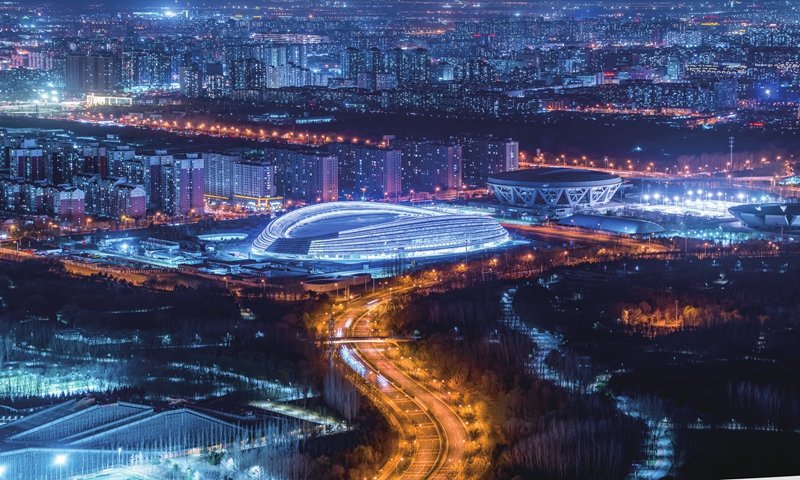
National Speed Skating Oval Photo:VCG
As the 100-day countdown to the Beijing 2022 Winter Olympics approaches, a number of topics on social media have generated millions of comments and discussions, of which the advanced technologies that will support the world-class sporting event have aroused wide attention.
Technologies have helped and will help the Beijing 2022 Olympic and Paralympic Winter Games in broadcasting, venue operation and athlete training, including air disinfection equipment, 5G base stations and artificial intelligence (AI) data analyses.
Full 5G coverage has been achieved in and around the Olympic venues, providing a guarantee for an “immersive” VR viewing experience to audiences.
Meanwhile, the highway and high-speed railway linking Beijing and Zhangjiakou, the co-host city in North China’s Hebei Province have also achieved full 5G coverage. The high-speed rail link between cities is equipped with wireless charging.
5G wireless networks can transfer large amounts of data to meet communication needs during major events.
Advanced technologies such as 360-degree replay and drones will also be used in the Beijing Winter Olympics.
Since the 2022 Olympic tickets will only be sold to spectators from the Chinese mainland due to the ongoing COVID-19 pandemic, 5G signals will allow high-definition broadcast on VR devices so that overseas audiences can attend events virtually online but feel as if they were at the venue.
The International Olympic Committee welcomes the decision, agreeing that safety should always remain the priority. Air disinfection equipment is crucial to guarantee the safety of all participants to the Games, as coronavirus can be transmitted through the air.
Fresh air
Geng Liang, a strategic account manager of Shenzhen Kangfeng Air Purification Technology Co, told the Global Times that the company’s large mobile air purifiers will support the Beijing Olympic Games.
“The mobile air purifier uses AOP-KF solid alkali as a filter, which can actively capture and eliminate bacteria in the air by releasing hydroxyl free radicals, ensuring that large closed venues have clean air all the time,” said Geng.
The purifiers have already been used in the 130th Canton Fair, the first on-site session since the outbreak of the pandemic. It closed with more than 600,000 visits in person, with no new COVID-19 case reported and zero contaminations.
The equipment has also been tested in the “Ice Altar” of Beijing Winter Olympic Games venue for six months demonstrating strong results, said the manager.
The venue will be used for games and training for multiple Olympics events including ice hockey and figure skating.
Other technologies used across the venues will guarantee smooth operations and increased efficiency.
For instance, a newly designed 5G smart car, which is able to detect the smoothness of the ice track surface with an accuracy of centimeters, can replace manual inspections.
The roughness of the track surface is used to depend on the manual observation and judgment. The new smart car uses 5G transmission technology based on the BeiDou Navigation Satellite System to detect the roughness of the surface and transfer data to the analysis center simultaneously, and then use data model to make a judgement.
The first snow wax car with complete intellectual property rights in China officially rolled off the production line on September 26, and was scheduled to be delivered to the national team on Wednesday, Taishan Sports Industry Group Co told the Global Times.
Ski wax can effectively improve the skis maneuverability and skiing speed, which directly affects athletes’ performance.
Training on high-tech
Apart from venues, trainings of athletes have also been supported by advanced technologies.
Just like the snow wax car, which helps during the winter sports training and also on competition site, micropressure oxygen enrichment equipment can help athletes quickly recover their physical fitness.
The equipment was displayed throughout the China Beijing International High-tech Expo in September. The oxygen-enrichment facility is a circular chamber about three cubic meters in size, surrounded by leather materials, with a comfortable bench, a table and testing equipment.
“The accumulation of fatigue caused by long time heavy load training affects the training effect. Athletes can eliminate fatigue in just 50 minutes using the equipment,” a staffer surnamed Zhang of PERIC Hydrogen Technologies Co, told the Global Times.
Moreover, AI data analysis is used for figure skating training. Training videos of the athletes will be made into 3D models of the human body, and AI can analyze data to pinpoint the technical parameters that affect athletes’ performance, such as the mode of power generation, jump time and rotation speed.
Low-speed wind tunnels are also used to measure the aerodynamic drag of athletes and provide wind resistance training for athletes.
Credit: Source link





















